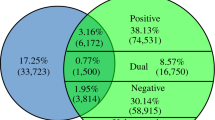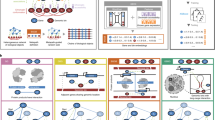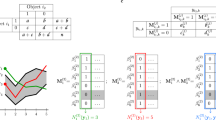Abstract
Standard clustering methods can classify genes successfully when applied to relatively small data sets, but have limited use in the analysis of large-scale expression data, mainly owing to their assignment of a gene to a single cluster. Here we propose an alternative method for the global analysis of genome-wide expression data. Our approach assigns genes to context-dependent and potentially overlapping 'transcription modules', thus overcoming the main limitations of traditional clustering methods. We use our method to elucidate regulatory properties of cellular pathways and to characterize cis-regulatory elements. By applying our algorithm systematically to all of the available expression data on Saccharomyces cerevisiae, we identify a comprehensive set of overlapping transcriptional modules. Our results provide functional predictions for numerous genes, identify relations between modules and present a global view on the transcriptional network.
This is a preview of subscription content, access via your institution
Access options
Subscribe to this journal
Receive 12 print issues and online access
$209.00 per year
only $17.42 per issue
Buy this article
- Purchase on Springer Link
- Instant access to full article PDF
Prices may be subject to local taxes which are calculated during checkout







Similar content being viewed by others
References
Bittner, M., Meltzer, P. & Trent, J. Data analysis and integration: of steps and arrows. Nature Genet. 22, 213–215 (1999).
Cheng, Y. & Church, G.M. Biclustering of expression data. Proc. Int. Conf. Intell. Syst. Mol. Biol. 8, 93–103 (2000).
Getz, G., Levine, E. & Domany, E. Coupled two-way clustering analysis of gene microarray data. Proc. Natl Acad. Sci. USA 97, 12079–12084 (2000).
Eisen, M.B., Spellman, P.T., Brown, P.O. & Botstein, D. Cluster analysis and display of genome-wide expression patterns. Proc. Natl Acad. Sci. USA 95, 14863–14868 (1998).
Alon, U. et al. Broad patterns of gene expression revealed by clustering analysis of tumor and normal colon tissues probed by oligonucleotide arrays. Proc. Natl Acad. Sci. USA 96, 6745–6750 (1999).
Tamayo, P. et al. Interpreting patterns of gene expression with self-organizing maps: methods and application to hematopoietic differentiation. Proc. Natl Acad. Sci. USA 96, 2907–2912 (1999).
Mewes, H.W. et al. MIPS: a database for genomes and protein sequences. Nucleic Acids Res. 30, 31–34 (2002).
Costanzo, M.C. et al. The yeast proteome database (YPD) and Caenorhabditis elegans proteome database (WormPD): comprehensive resources for the organization and comparison of model organism protein information. Nucleic Acids Res. 28, 73–76 (2000).
Costanzo, M.C. et al. YPD, PombePD & WormPD: model organism volumes of the BioKnowledge library, an integrated resource for protein information. Nucleic Acids Res. 29, 75–79 (2001).
Zimmerman, Z.A. & Kellogg, D.R. The Sda1 protein is required for passage through start. Mol. Biol. Cell 12, 201–219 (2001).
Buscemi, G., Saracino, F., Masnada, D. & Carbone, M.L. The Saccharomyces cerevisiae SDA1 gene is required for actin cytoskeleton organization and cell cycle progression. J. Cell Sci. 113, 1199–1211 (2000).
Fikus, M.U. et al. The product of the DNA damage-inducible gene of Saccharomyces cerevisiae, DIN7, specifically functions in mitochondria. Genetics 154, 73–81 (2000).
Liu, Z. & Butow, R.A. A transcriptional switch in the expression of yeast tricarboxylic acid cycle genes in response to a reduction or loss of respiratory function. Mol. Cell. Biol. 19, 6720–6728 (1999).
Bojunga, N. & Entian, K.D. Cat8p, the activator of gluconeogenic genes in Saccharomyces cerevisiae, regulates carbon source-dependent expression of NADP-dependent cytosolic isocitrate dehydrogenase (Idp2p) and lactate permease (Jen1p). Mol. Gen. Genet. 262, 869–875 (1999).
Milkereit, P. et al. Maturation and intranuclear transport of pre-ribosomes requires Noc proteins. Cell 105, 499–509 (2001).
Harnpicharnchai, P. et al. Composition and functional characterization of yeast 66S ribosome assembly intermediates. Mol. Cell 8, 505–515 (2001).
Acknowledgements
We thank D.R. Kellogg for the sda2-1 strain; U. Alon, M. Dolev, E. Domany, A. Eldar, O. Gileadi, Y. Kafri, B.-Z. Shilo and S. Shnider for discussions and comments on the manuscript; G. Jona and O. Gileadi for experimental help. This work was supported by the US National Institutes of Health, the Israeli Science Ministry and the Benoziyo center. S.B. is a Koshland fellow. N.B. is the incumbent of the Soretta and Henry Shapiro career development chair.
Author information
Authors and Affiliations
Corresponding author
Ethics declarations
Competing interests
The authors declare no competing financial interests.
Supplementary information
Rights and permissions
About this article
Cite this article
Ihmels, J., Friedlander, G., Bergmann, S. et al. Revealing modular organization in the yeast transcriptional network. Nat Genet 31, 370–377 (2002). https://doi.org/10.1038/ng941
Received:
Accepted:
Published:
Issue Date:
DOI: https://doi.org/10.1038/ng941
This article is cited by
-
RUBic: rapid unsupervised biclustering
BMC Bioinformatics (2023)
-
Finding disease modules for cancer and COVID-19 in gene co-expression networks with the Core&Peel method
Scientific Reports (2020)
-
Identification of vital regulatory genes with network pathways among Huntington’s, Parkinson’s, and Alzheimer’s diseases
Network Modeling Analysis in Health Informatics and Bioinformatics (2020)
-
Transcription factor regulatory modules provide the molecular mechanisms for functional redundancy observed among transcription factors in yeast
BMC Bioinformatics (2019)
-
Gene co-expression network analysis reveals pathways associated with graft healing by asymmetric profiling in tomato
BMC Plant Biology (2019)



